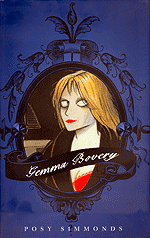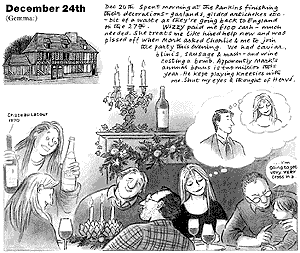
|
First serialized during the late '90s in the UK newspaper The Guardian, "Gemma Bovery" looks nothing like the mirthless "funnies" Americans have gotten used to in their daily papers. One can scarcely imagine the generosity of space and wit that would be needed to accommodate Simmonds' striking compositions, much less her racy and literate subject. As clever with her brush as she is with her typewriter, Posy Simmonds seamlessly matches swatches of strongly written text with expert spot illustrations and uproarious traditional panel sequences. "Gemma" makes for a rich reading experience, as well as a rewarding one.
Simmonds opens with the line, "Gemma Bovery has been in the ground three weeks." This somewhat surprising beginning — we knew she was going to die, after all, but as soon as that? — immediately establishes the author's playful post-modernism. "Gemma" completely avoids the pitfalls of being too close to the original text or too blithely ironic or too coyly obtuse. Instead it uses the original novel as a key plot point. The narrator of "Gemma Bovery," a French intellectual-turned-baker in a small Normandy village, becomes convinced that Gemma, an English expatriate, has been cursed to follow the course of Emma Bovary's sad life. At one point he sends her pages of the book as a warning. Gemma won't have any of it.
The evidence, however, is against her. For one thing, Gemma is as dull, pretentious and hopelessly middle class as her literary doppelganger, though, as a modern woman, she makes a living as an illustrator living in London. Rebounding off of a failed relationship with someone even more narcissistic than herself, she marries an older divorcee named Charlie Bovery. (Strike two!) As the routine of married life begins gnawing at her, she fantasizes about a quaint life in rural France. (Uh oh.) After hounding her husband to move she soon becomes bored and claustrophobic. So she takes a lover, a young law student, and the rest is literature.
Wisely, Simmonds makes sure that knowledge of the original material isn't a prerequisite for enjoying "Gemma." Though it takes a bit of getting used to the mixture of text and comix, it rewards patience with its involving story that offers plenty of unexpected twists. One of the book's particular pleasures is its caustic examination of the English and French culture clash. The wealthy Anglais who buy property in Normandy but never bother to interact with the natives, short of buying bread and cheese, are held up to scorn, as are the snobby nouveau riche native French who hold the English in contempt. (One point of criticism: the inconsistent style of leaving the French untranslated in some cases and fully translated in others becomes annoying.)
 Gemma thinks of her lover thinking of her while Charlie (foreground) remains oblivious
Gemma thinks of her lover thinking of her while Charlie (foreground) remains oblivious |
Just as the power of Flaubert's original novel comes from the author's almost clinically objectivist approach, the humor of "Gemma" springs from Simmonds' dead-on observation. Thanks to the use of Gemma's diaries as part of the narrative, "Gemma Bovery" often feels like a caustic and richly deserved counterpoint to the irritating Bridget Jones franchise. Imagine Bridget on amphetamines and you have a fair idea of Gemma Bovery. The characterizations of Gemma as a rudderless yuppie, Charlie as the befuddled schlub, various French and English twits and even Joubert, the largely sympathetic baker/narrator are all razor sharp satires that always have enough humanity to keep them from becoming two-dimensional.
Simmonds' keen characterization comes from both her clever writing and exceptional drawing skills. Using what looks like a soft pencil and gray wash, she creates naturalistic drawings that camouflage what are actually carefully composed arrangements of gesture, posture and facial affect. One remarkable panel shows a Christmas dinner party at which Gemma and Charlie are seated. The hostess looms to the left, while a man scolds a child at the right, with all the other characters carefully positioned in the space to display a different state of mind. In a brilliantly satiric take on selfish love, Simmonds uses a thought balloon inside a thought balloon as Gemma fondly thinks of her lover fondly thinking of her.
Social satires tend to be pretty crude affairs in the world of comix. Cartoonists tend to succumb to the genre's temptations of broad, easy caricature. Posy Simmonds avoids this with her particularly English dry wit. Rich with memorable characters, literary depth, cutting humor and pictorial panache, "Gemma Bovery" sets a new standard for intelligent cartoon satire in graphic novel format.
